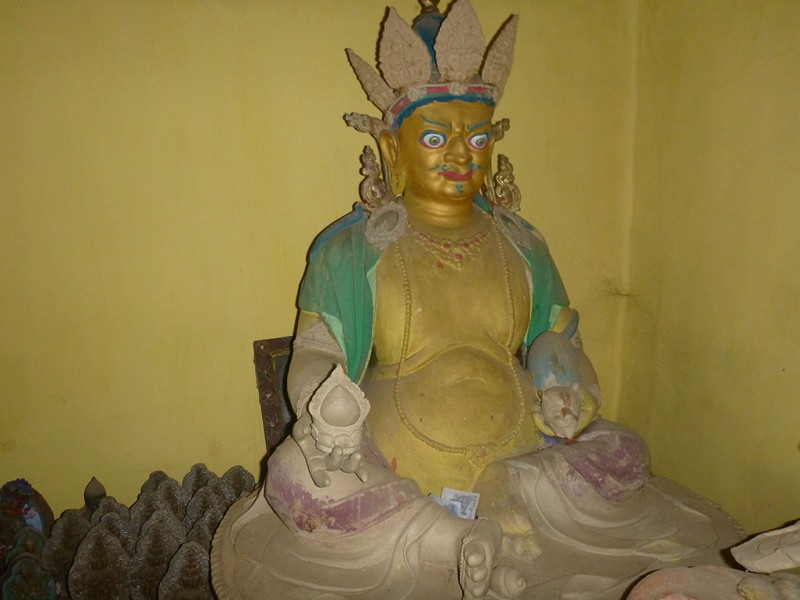Description
Yueling Namgyel Choling Lhakhang is located in Yueling Village, which is a thirty-minute walk from the Sherubling Higher Secondary. We can also drive to the site, which is 7 kilometers away from Trongsa town and provides a nice vantage point from which to view Trongsa town.
History
Definitive dates and history of the temple’s construction are not yet known. Nevertheless, the Lhakhang is a sacred one because of its association with Yongzin Ngagi Wangchuk (1517-1555), who was the great grand-father of the Zhabdrung Ngawang Namgyel.

Yongzin Ngagi Wangchuk was from the Drukpa ruling family and travelled from Tibet to Bhutan. Guided by a vision of the guardian deity Palden Lhamo, he arrived in the Trongsa (Mangdu) region in 1541, and stayed in Yueling village before the construction of Trongsa Dzong. It is said that Yongzin Ngagi Wangchuk built a small meditation retreat (Tshamkhang)under the patronage of three villages: Yueling, Lashing and Tsengbi.
One night, while Yongzin Ngagi Wangchukwas meditating, his attention was drawn by a flicker of light, resembling that of butter lamp burning in the open air, at the spot where the present day protective deity’s temple (Goenkhang) of the Trongsa Dzong is located. In 1543, Yongzin Ngagi Wangchuck established a small meditation retreat (Tshamkhang) in the sacred spot and meditated there. Soon after, Lama Ngagi Wangchuck moved to where the present Trongsa Dzong stands. The retreat later became a center of worship for the three villages of Yueling, Lashing and Tsengbi.
With the passage of time, the meditation retreat became decrepit. A major renovation of the temple started in 2011, with construction of a two-story temple. The village received a half million Ngultrum from the local government fund for the renovation. At present the temple is looked after by the Yueling community members. The caretaker of the temple is appointed on a rotational basis, each household holding the post for the period of three years. The caretaker is responsible for the supervision of daily offerings and the coordination of work in the temple.
The main relics inside the Lhakhang are said to be from Yongzin Ngagi Wangchuk’s time, while the clay statue of Ngagi Wangchuck himself and other relics were included by devotees later on.
Architecture and art work
The newly constructed temple is based on traditional Bhutanese architecture for temples. The woodwork and masonry of the temple is very attractive. On the first floor, the temple has space where people can stay and spend the night during auspicious days or other occasions, and also has a store room. On the second floor, one finds the main altar room, where relics are kept. On the right side of the main altar, there is the Goenkhang for Pekhar Gyalpoand a room reserved for the lama to reside while performing ceremonies, rituals, the annual Tshechu and Nyungne (fasting and prayers) during auspicious occasions. A common kitchen is located on the right side of the temple.

The main relics inside the Lhakhang consist of clay statues of the historical Buddha and Pekhar Gyalpo (a fierce protective deity), which are believed to have been there since Yongzin Ngagi Wangchuk’s time. There are also clay statues of Guru Rinpoche, Chenrezi (Avalokitshvara), Jowo Jampa (Maitreya the future Buddha), Zambalha (Kubera), and Chana Dorji (Vajrapani, the protector of Buddha). Small statues of the Neten Chudruk (the sixteen famous elders, called Arhats, who preached the Buddhist doctrine) are also there. There are also sets of the Kangyur (teaching of the Buddha) and the Tengyur (commentaries on the former), and a statue of Avalokitshvara with 11 heads (Chuchig Je). The clay statue of Ngagi Wangchuck himself and other relics in the temple are those which were included by devotees later on.
Social and cultural functions
The temple enables the community to perform prayer ceremonies, rituals, the annual Tshechu and Nyungne (fasting and prayers) on certain dates to accumulate merit and purify defilements for senior and elders who cannot travel far at their age. Yueling community also performs rituals throughout the year, on every 10th, 15th and 30th day of Bhutanese calendar months.
According to oral sources, nobody knows who initiated the various rituals in the temple, but they have been performed under the patronage of the village community themselves. Every year on the 9th and 10th day of the 7th month in the Bhutanese calendar they conduct Teldhey Leywaidhenma (prayer dedicated to Guru Rinpoche). On the 15th day of the 10th month, a one-day Kuchoe (death anniversary) is observed and dedicated to Yongzin Ngagi Wangchuk, the founder of temple. An eight-day Nyungne is conducted from for the 28th day of the 11th month to the 6th day of the 12th Bhutanese month. It is dedicated to benefit all sentient beings and eradicate all misfortune in the community.
Starting from 2014, Yueling community also initiated celebration of the Zhabdrung Kuchoe. This celebration is dedicated to the founding father of Bhutan, the Zhabdrung Ngawang Namgyel.
Informant
Aum Choden Pelmo, 56 years old, caretaker, 2014
Researcher/photographer
Sangay Phuntsho (K), Asst. Lecturer, Institute of Language and Culture Studies, 2014
 755
755